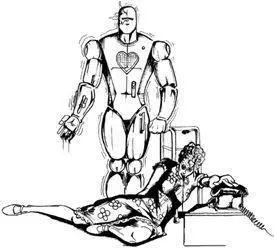However, in an attempt to set the new world record for Worst Decision Made by Anybody, scientists at the University of Florida have developed a robot that powers itself on meat. The robot, cutely dubbed the “Chew-Chew,” is equipped with a microbial battery that generates electricity by breaking down proteins with bacteria. Though Chew-Chew is not limited solely to meat—the battery can “digest” anything from sugar to grass—the scientists went on to explain that by far the best energy source is flesh. This is partly due to the higher caloric energy inherent in meat, and partly because of the little known but intense enmity between scientists and vegans. The inventors cite some fairly innocent uses for the technology—like lawnmowers that power themselves by eating grass clippings—but presumably this is because it just never occurred to the scientists that, of the “Top-Ten Worst Things That Want to Chew on You,” your own lawnmower easily cracks the top three. However, the assumption that these are simply good-natured scientists unaware of the dastardly consequences of their actions just doesn’t hold up, as lead inventor Stuart Wilkinson proves: He’s on record as stating that he is “well aware of the danger” and hopes that the robots “never get hungry,” otherwise “they’ll notice there’s an awful lot of humans running about and try to eat them.” Professor Wilkinson is currently being investigated under charges of “Why the Fuck Did You Invent It, Then?” by the board of ethics at his institution, but is likely to be cleared of all charges when his army of starving lawnmowers organizes and “protests” for his freedom.
The Chew-Chew is a specific robot, but the entire concept isn’t exactly new. Robots that eat for fuel are dubbed “gastrobots” and for now are relatively harmless; the Chew-Chew, for example, is just a twelve-wheeled rail-bound device that has to be fed sugar cubes to power the gastronomic process.
Ways to Defeat the Chew-Chew
• Don’t stand on the tracks.
• Wear knee-high boots.
• Substitute calorie-rich sugar with Splenda.
Of course, though experiments like Wilkinson’s are some of the first innovations in the field, the technology has been refined since then. Apparently a number of robotics engineers have a bizarre fetish involving being chewed and digested in the cold steel guts of metal beasts, because there’s a slew of these things out there now—a robot being developed at the University of the West of England that eats slugs, for one. But as long as it stops somewhere short of government contracts being penned for flesh-eating robots, I suppose humanity will end up all right.
Oh, surely you didn’t think it was going to stop at a reasonable level of terror, did you? That’s adorable!
But no, science is not just teaching toy trains to eat sugar. If the world was that innocent, we’d all be riding unicorns to our jobs at the kitten factory where the only emissions would be rainbows and kitten sighs. Sadly, ours is a world of far more terrible consequences: We’re currently building war bots that power themselves on corpses. The robot-digestion engine is being developed right now by a corporation called Cyclone Power, and they prefer to refer to it as a “beta biomass engine system.”
Yeah, sure.
I like to tell the police that I’m practicing “body freedom,” but in the end I still get arrested for indecent exposure; you fuckers built a carnivorous robot. Just own up already, and admit that what you’ve dubbed the Energetically Autonomous Tactical Robot is really a—
Wait… oh God. Did you get that?
Energetically Autonomous Tactical Robot: EATR.
OK, never mind: It’s clear that nobody is trying to disguise the fear factor of this technology. When “Cyclone Power” unveils their “EATR war bots,” it’s plain to see that nobody is worrying about comforting marketing jargon. An announcement that straight-up threatening would make Cobra Commander anxiety-puke into his face mask. That is villainy, pure and simple, so we can harp on Cyclone Power all we want; at least they’re being up front about it.
The EATR is programmed to forage from any and all available “biomass” in the field, and is primarily geared toward the more long-term military missions such as reconnaissance, surveillance, and target acquisition. It can accomplish these tasks “without fatigue or stress,” unlike its human counterparts, according to the financiers at DARPA. One example given for a potential use of the EATR technology was a bunker-searching robot in the mountainous caves of Afghanistan and Pakistan. And that is a brilliant idea, because what better way is there to win the War on Terror than to show the so-called terrorists that they don’t know the meaning of the word until they’ve watched their friends and allies being dragged into darkened caves, where they are devoured by unfeeling robots?
Excerpts from the Brainstorming Session for the EATR
“… so anyway, this robot basically eats people for fuel. I figured we could make it completely autonomous, send it into some remote caves, and hopefully no groups of plucky young teenagers will camp out near there to have R-rated sex or split up to find their missing friends or something.”
“How exactly is this going to help win the War on Terror?”
“‘War ON Terror’? Haha! Sorry, I have ‘War OF Terror’ written here. My bad! Good thing we caught that in time, eh?”
Some other examples cited by DARPA were: use in nuclear facilities, border patrol, communication networks, and missile defense systems. So basically, we’ve barely started developing the technology for carnivorous robots, but we’ve already handed over all the most important military positions to them before they were even deployed. At least we were smart enough to surrender in advance. Maybe they’ll require a virgin sacrifice only every fortnight, if we’re lucky.

OF COURSE, THIS is all just cynical anthropomorphizing, isn’t it? I’m just assuming that robots want to kill us all while, at best, that’s probably only 90 percent true. Robots are logic, pure and simple. Hatred, murder, lust—they’re the flip side to the positive aspects of human emotion like friendship, love, and charity. We pay the priceof negative emotional states because they come attached at the hip with the positive. So, for robots to truly be sociopathic murder machines, they’d have to be a lot more human, showing a history of disobedience, immorality, or emotional frailty. It’s not like there’s a surging demand for automatons with neurotic complexes, so why on Earth would anybody engineer those traits into a robot? Ask David McGoran at the University of the West in England, who in 2008 proudly displayed the Heart Robot, a machine that responds to love and affection. The Heart Robot gives pleasant reactions to affectionate gestures like being hugged, and displays negative reactions to spiteful actions like being scolded or abused. Presumably this is because the science department at the University of the West is staffed by Care Bears, but their official line is that they’re attempting to study how people react to robots as emotionally viable beings. Or the converse could be true—that they’re just bitter, bitter men who, if they can’t break human hearts in spiteful revenge for their failed relationships, will just goddamn build a robot one to ruin instead. But I believe in the good and the awesome among scientists, no matter how many times they’ve personally tried to murder all that I love within the confines of this chapter alone. No, the Heart Robot is built to love, and it does so superbly. It has a beating heart that surges with excitement and slows with comfort. It flutters its eyes in response to touch, simulates rising and falling breathing motions, and responds to both noise and touch. He likes to be cuddled and cooed to, so his breathing evens out and his heart slows.
Читать дальше













